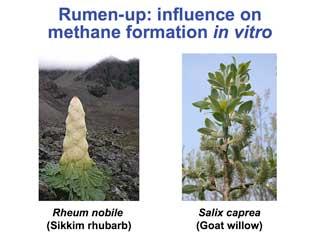Ruminants And Methane
Published on 5 February 2010 in Climate, water and energy

Introduction
Ruminants emit methane (CH4) as a natural part of their digestive processes. A dairy cow can produce as much as 500 L per day. Methane is a potent greenhouse gas, 21 times as effective as CO2 in its 'radiative forcing'.
How damaging is the methane produced by ruminants therefore? Two rules of thumb provide some perspective. Firstly, globally, ruminants emit an amount of methane equivalent to the total amount of greenhouse gas emissions by the airline industry. That sounds a lot, but arguably a better perspective is that, roughly speaking, in greenhouse gas terms, one cow = one car. When you think of the numbers of cars we use, and consider as well that methane has a half-life in the atmosphere of 12 years, whereas that of CO2 (produced by cars) is many centuries, methane produced as a by product of food production is really the wrong target if we are to have a major effect on climate change. Nevertheless, if we can prevent methane production by ruminants, not only would we stop the emission of a greenhouse gas, the energy that would otherwise be lost to the atmosphere is retained as a nutrient, and the animals would grow more efficiently. Helping to fulfil the ambitions of Kyoto, Rio and Copenhagen would also lead to more profit for the farmer.
Key Points
- Methane is formed in the rumen, which is the first digestive organ in cattle, sheep, goats and deer. The methane is formed by microbes known as ‘archaea’. Archaea take hydrogen and CO2 produced by other microbes to form methane:
4H2 + CO2 = CH4 + 2H2O
- One strategy we and others have shown to be moderately effective in preliminary experiments is to use certain herb or other plant extracts as feed additives to inhibit archaea directly.
- A second strategy that has sometimes proved even more effective is to trap the H2 before it can be used by the archaea. Preparations based on fumaric acid have worked well in lambs.
Research Undertaken
Scientists at the Rowett Institute of Nutrition and Health (RINH) have led two major EC initiatives to discover plants and plant extracts that, when added to the feed, could lower the methane emissions of cattle and sheep. The discovery phase of these projects went well, a dozen or so plants being identified to be of potential usefulness. These include Rheum nobile, known as Sikkim rhubarb (illustrated), Allium sativum (garlic) and Salix caprea (goat willow). The application of some of these plants was the subject of a patent taken out by the consortium partners. The maximum inhibition imposed by any individual plant was only about 25% of total methane formation, however.
The alternative ‘trapping’ strategy investigated by RINH scientists also provided a number of good candidates. These ‘hydrogen sink’ compounds can divert H2 away from the archaea. The best of these was fumaric acid, a natural Krebs cycle metabolite that is found in all animals. Ruminal bacteria convert fumaric acid to succinic acid using H2. Thus, less H2 is available for methane production by the archaea. The succinic acid is converted to propionic acid, which is a normal product formed by ruminal bacteria and which is absorbed into animal tissues to form glucose and amino acids.
Using fumaric acid as a feed additive was found to be problematic because it caused the gut contents to become too acidic. We devised a slow-release mechanism that circumvented this problem. Subsequent trials of the slow-release fumaric acid in a lamb trial gave a 75% inhibition of methane formation; coupled to this was a 10% improvement in feed conversion efficiency. A dairy cow trial proved unsuccessful, however. The slow-release mechanism did not work in the cows, and needed to be reformulated.
Many opportunities remain for mitigating methane emissions from ruminants. A reformulated slow-release fumaric acid might be effective in dairy cows. Combining additives has never been explored properly. Alternating their use might be better, minimising any microbiological adaptation away from the inhibitory effects. There is also anecdotal evidence that certain individual animals emit less methane than others and that this difference might therefore be heritable. The best way to understand the effectiveness of different treatments would be to understand how the archaeal community responds, but although the bacterial communities of Scottish cattle and sheep have been characterized, their archaeal community has not.
Policy Implications
- The rural economy of Scotland means that methane emissions constitute a higher proportion of her greenhouse gas emissions than other parts of the UK
- Carbon taxation is being discussed as a serious option to limit GGE
- The Scottish government, in its Climate Change (Scotland) Bill, has pledged to lower its GGE by 80% by 2050.
Author
Professor John Wallace John.Wallace@abdn.ac.uk







